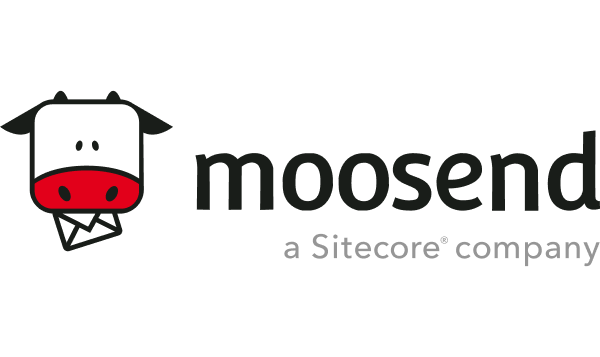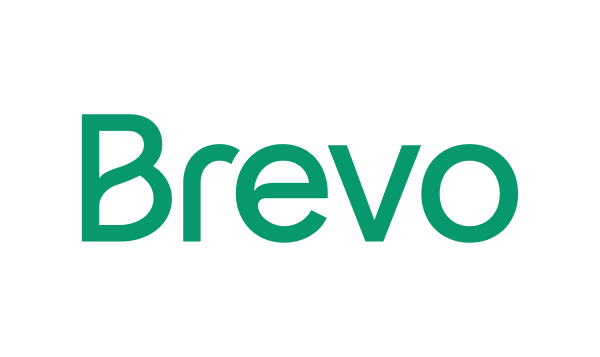Finding the right email marketing platform can feel like searching for a needle in a haystack. Mailjet is a solid option, but it’s definitely not a one-size-fits-all solution.
Perhaps you’re looking for alternatives to Mailjet for startups or seeking to replace Mailjet entirely. This article explores ten excellent competitors, catering to various needs and budgets.
Disclaimer: This article evaluates Mailjet alternatives, including Sender, which our company owns. Assessments are based on research, industry standards, and user feedback. No commissions are earned from links in this article.
Why Consider Mailjet Alternatives?
While Mailjet offers a user-friendly interface and competitive pricing, users have highlighted several areas where the platform falls short, prompting them to explore Mailjet alternatives. Let’s review these pain points:
Email Deliverability
While certainly not the worst (that title goes to Benchmark at 50%), Mailjet’s email deliverability rate is definitely not great.
Based on our time with this email marketing tool and Emailtooltester folks’ findings, Mailjet’s deliverability hovers around 82-84% (as compared to Sender’s 99% deliverability). And that checks out, as plenty of Mailjet users complain about emails ending up in ‘spam’ folders. (G2)
Features & Functionality
Mailjet offers a solid set of features, with strengths in team collaboration, an easy drag-and-drop editor, and reliable transactional email support. Segmentation and personalization are available, along with A/B testing and basic automation workflows.
Users appreciate its real-time multi-user access and campaign approval tools, which are standout features compared to many competitors—particularly when managing promotional campaigns.
However, automation is limited to simple triggers, and segmentation logic isn’t as advanced as on other providers. The template library feels thin, customization can be restrictive, and some functions are hard to find. (Trustpilot)
Platform Reliability
Mailjet’s reliability is a mixed bag, with performance that often feels inconsistent. While it compensates for subpar deliverability with a user-friendly interface, there are plenty of concerns surrounding its overall reliability.
For instance, some users report abrupt account suspensions without clear explanation, creating uncertainty for ongoing campaigns. Others mention that important features can feel hidden or overly complex, adding friction for teams trying to work efficiently. (G2)
Integration Ease
Mailjet’s integration library also feels limited compared to competitors. The WordPress plugin is useful, showing email stats in the dashboard, and WooCommerce covers basic e-commerce needs. But beyond that, options feel thin.
Salesforce integration exists but lacks depth, and the absence of a native Shopify connection is frustrating—Zapier workarounds often add delays and failure points. Users note that Google Analytics requires UTM parameters, while Microsoft Dynamics offers only basic sync. Though Zapier technically unlocks thousands of apps, reliance on it creates fragility. (G2)
Cost & Pricing
- Free plan: $0 with up to 6,000 emails/month + 1,000 contacts;
- Essential plan: $17/month with up to 15,000 emails/month + unlimited contacts;
- Premium plan: $27/month with up to 15,000 emails/month + unlimited contacts;
Mailjet’s pricing is relatively budget-friendly, making it perfect for small teams and startups. The basic free plan is a nice entry point too, though its daily limits and feature restrictions mean it’s mostly for testing out the waters. While it isn’t the priciest option on the market, its value depends on whether you need the advanced functionality tucked into enterprise plans. (Trustpilot)
Growth & Scalability
Mailjet’s scalability shows clear limitations as businesses grow. Automation triggers are basic, with little support for complex workflows or branching logic, often forcing rebuilds when strategies change. At higher volumes, businesses often end up requiring a custom plan to meet their needs.
Some reviews report performance issues like lag or freezing during larger sends, making reliability a concern for high-volume campaigns. Advanced marketers also find Mailjet’s tools too simplistic for evolving needs, with limited flexibility in automation and segmentation. (Trustpilot)
Mailjet Alternatives: A Quick Comparison
Too many alternatives to choose from? Here’s a handy Mailjet comparison table to help you decide:
| Brand | Free Plan Details | Starts At | Best For |
| Mailjet | 6,000 emails/month, 200 emails/day, 1,000 contacts, basic features | $17/month for 15,000 emails | Small businesses, teams needing collaboration, startups |
| Sender | Up to 2,500 subscribers, 15,000 emails/month, includes automation and templates | $7/month for 1,000 contacts | SMBs, ecommerce, startups |
| ActiveCampaign | No free plan; only 14-day free trial | $15/month for up to 1,000 contacts | Agencies, ecommerce, SMBs |
| Mailchimp | Up to 500 contacts, 1,000 emails/month, 500 emails/day | $20/month for 500 contacts | Enterprises, marketing teams, agencies |
| GetResponse | No free plan; only 30-day free trial | $15/month for 1,000 subscribers | Ecommerce, SMBs, marketing teams |
| Moosend | No free plan; only 30-day free trial with basic features | $7/month for 500 subscribers | Ecommerce, small businesses, nonprofits |
| Constant Contact | No free plan; only 30-day free trial | $12/month for up to 500 contacts | SMBs, ecommerce, nonprofits |
| Brevo | 300 emails/day, up to 100,000 contacts, includes transactional emails and SMS campaigns | $8/month for 5,000 emails | E-commerce, startups, content creators |
| SendGrid | No fee plan. 100 emails/day for 60 days | $20/month for up to 100,000 emails | Developers, SaaS platforms, marketplaces |
| Mailgun | 100 emails/day, 1 custom domain, basic analytics | $15/month for 10,000 emails | SaaS companies, ecommerce platforms, developers |
| Postmark | 100 email/month | $15/month for 10,000 emails | Ecommerce platforms, SaaS companies, financial institutions |
6 Best Mailjet Alternatives for Sending Marketing Emails
If you’ve been searching for tools like Mailjet or email services like Mailchimp, look no further. Here are the top Mailjet competitors on the market today:
Sender — Best Alternative to Mailjet for SMBs
If you come from small businesses and search for affordable Mailjet alternatives that don’t compromise on features, Sender is your best bet.
This email marketing service is designed with small and medium-sized businesses in mind, offering an outstanding balance of affordability and functionality.
Sender pricing: Starts at $7/month for up to 1,000 subscribers and 12,000 emails/month | Generous Sender Free Plan available.
Its advanced automation outperforms Mailjet’s basic workflows, while powerful segmentation tools let you target subscribers based on demographics, actions, and engagement, ensuring every email feels relevant and impactful.
This all-in-one email marketing service goes beyond email with a built-in landing page builder. You can easily create high-converting signup forms and funnels without extra tools, though I found Sender’s builder to be more intuitive and responsive than Mailjet’s.
When it comes to the integration ecosystem, this tried-and-tested bulk email sender delivers where Mailjet falls short (at least to this reviewer’s liking). You’re able to connect seamlessly with platforms like Shopify, WooCommerce, or Magento to run targeted campaigns and automate customer follow-ups, something Mailjet doesn’t handle as smoothly.
Add in detailed analytics for smarter optimization and a generous Forever free plan, and Sender becomes more than just another outstanding Mailjet alternative—it’s an engine for growth.

Key Features
- Advanced automation features. Sender offers powerful yet easy-to-use automated workflows and SMS marketing tools — ideal for targeted campaigns and lead generation;
- Deep personalization & segmentation. Use contact data to trigger personalized email and SMS messages at scale;
- Real-time analytics & email reports. Track email marketing campaign performance with detailed email reports that include delivery, open, click, and conversion rates;
- A/B testing. Optimize performance by testing subject lines, content, and send times to find the winning combination for maximum engagement;
- Landing page builder. Create sign-up pages, promotions, or product showcases in minutes with drag-and-drop layouts and mobile-optimized designs—completely code-free.
Pros and Cons
| Feature | Sender | Mailjet |
| Free plan | Yes (Free tier with 15,000 emails/month) | Yes (Free tier with 6,000 emails/month) |
| Automation | Advanced automation workflows, including SMS marketing | Basic automation features |
| Segmentation & personalization | Powerful segmentation by demographics, actions, engagement | Standard list segmentation |
| Landing page builder | Yes (intuitive drag-and-drop, mobile-optimized, funnels) | Yes (drag-and-drop, but less flexible) |
| A/B testing | Yes (subject lines, content, send times) | Yes (limited A/B testing) |
| Dedicated IP | Dedicated IPs available on higher tiers | Dedicated IPs offered, but no advanced dedicated IP pools |
| Ecommerce integrations | Deep integrations with Shopify, WooCommerce, Magento | Limited ecommerce integrations |
| Analytics & reporting | Real-time, detailed reports (delivery, opens, clicks, conversions) | Standard campaign analytics |
| Customer support | 24/7 Email & chat support + resources | Email support, live chat for premium plans |
Mailjet vs. Sender
Mailjet excels at team collaboration, but Sender is the stronger choice for growing businesses. Its advanced automation supports complex workflows that Mailjet can’t match, and the built-in SMS makes true omnichannel campaigns possible.
Sender also includes a landing page builder, giving marketers more flexibility without extra tools. Pricing scales more smoothly as well—I’ve saved hundreds each month since switching. That said, if seamless collaboration is your top priority, Mailjet still has the edge.
ActiveCampaign — Email Marketing Automation with CRM
I’ve found ActiveCampaign to be an excellent Mailjet alternative if you’re looking for something beyond simple newsletters and want more powerful automation.
For starters, its deliverability is excellent—ActiveCampaign scores 94.2%, which is noticeably higher than Mailchimp’s 89.5% and comes in second only to Sender. That extra bump really boosts the chances of your campaigns actually landing in the inbox.
ActiveCampaign pricing: Starts at $15/month for up to 1,000 contacts and up to 10,000 emails/month | 14-day free trial available.
Beyond deliverability, what really makes ActiveCampaign shine is their automation tools, which are top-notch. You can build behavior-based workflows without touching code, using triggers like opens, site visits, goals, or custom events.
I also enjoyed their Customer Experience Automation, which ties everything together across email, SMS, and even chat support. It tracks engagement across all these touchpoints and uses it to personalize customer journey, creating a much more cohesive experience.
While it offers far more sophistication than the simpler tools, ActiveCampaign is actually cheaper than Mailjet—making it an even stronger value for money given the advanced package you’re getting for the buck.
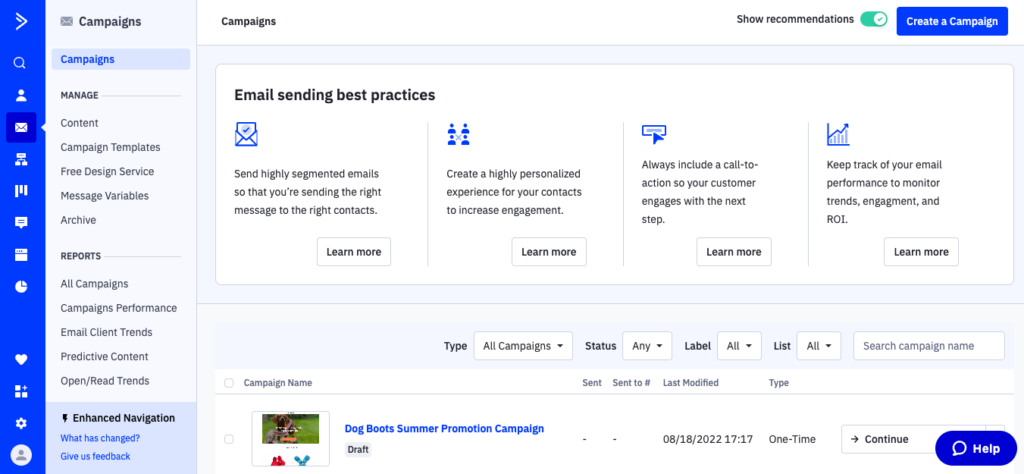
Key Features
- Deep CRM integration. Combine email and sales pipelines for seamless lead tracking with ActiveCampaign’s customer relationship management tools;
- Advanced conditional workflows. Automate complex sequences based on user behavior and preferences. Create powerful logic paths for every subscriber journey;
- Custom fields & tags. Segment and target with precision beyond basic list management. Personalize content at a granular level;
- Full analytics and goal tracking. Optimize every send–know exactly what’s working and adjust campaigns in real time.
Pros and Cons
| Feature | ActiveCampaign | Mailjet |
| Free trial | No (14-day trial) | Yes (Free tier with 6,000 emails/month) |
| Deliverability | 94.2% (among the highest in the market) | Mid-tier deliverability compared to competitors |
| Pricing | Starts at $15/month for 1,000 contacts & 10,000 emails/month | Starts at $17/month for unlimited contacts & 15,000 emails/month |
| Automation | Advanced behavior-based workflows, multi-channel automation (email, SMS, chat) | Basic workflows and triggers |
| CRM integration | Built-in CRM with lead tracking & sales pipeline management | No native CRM |
| Segmentation | Custom fields, tags, granular personalization | Standard list-based segmentation |
| Analytics & goal tracking | Full campaign analytics, goal tracking, engagement reports | Standard analytics and reporting |
| Multichannel | Yes (email, SMS, chat support, site tracking) | Primarily email-focused |
| Customer support | Live chat & email support across all plans | Email support; live chat for premium tiers |
Mailjet vs. ActiveCampaign
Mailjet is a solid option for creating campaigns easily, but ActiveCampaign is the stronger pick if you’re aiming for more advanced marketing. Its automation system supports behavior-based workflows far beyond what Mailjet can handle, and predictive sending helps maximize engagement.
ActiveCampaign also brings in SMS and chat alongside email, making cohesive, multi-channel campaigns much easier to run.
Pricing is another surprise—despite offering more depth, ActiveCampaign actually comes in cheaper than Mailjet, which makes it a better long-term value. That said, if you only need simple email campaigns with a bit of transactional capability, Mailjet still does the job.
We moved to ActiveCampaign from two separate systems — one a CRM and one an email marketing provider. Having the capabilities for both of these in one solution has been amazing. I love how easy it is to use ActiveCampaign for creating and sending our marketing emails.
— DJ from G2
Also read: 9 ActiveCampaign Alternatives That Actually Work (2025)
Mailchimp — All-in-One Email Marketing Software
A veteran of email marketing, Mailchimp has built its reputation around user-friendly interface and comprehensive set of features. Thanks to its scalability and ease of use, it’s a popular choice for businesses of all sizes, from small startups to large enterprises.
Mailchimp pricing: Starts at $20/month for up to 500 contacts and up to 10,000 emails/month | Mailchimp Free plan available.
Mailchimp offers a library of 130+ responsive templates to help you get started with campaigns quickly. Its drag-and-drop editor is also easier to work with than Mailjet’s one, making it simple to adapt layouts to your brand and messaging.
When it comes to customization, Mailchimp’s wide range of content blocks—images, videos, social buttons, and even dynamic content—provides more flexibility for building engaging, personalized campaigns than Mailjet’s editor typically allows.
Mailchimp also pulls ahead in analytics. You get detailed statistics and insights into open rates, click-throughs, unsubscribes, and more, making Mailjet’s analytics experience feeling rather lacklustre when put next to Mailchimp.

Key Features
- Pre-built automation templates. Provides a wide variety of customizable templates for different campaign types. Jumpstart your email design, even without coding knowledge;.
- Creative studio. Centralized hub for brand assets, content, and design tools. Maintain brand consistency across campaigns effortlessly;
- Audience insights. Offers smart suggestions for segmentation, send times, and content. Improve results using predictive insights and user behavior;
- Extensive integrations. Connect with ecommerce, CRM, and analytics tools out of the box. Great for businesses already using a wide tool stack.
Pros and Cons
| Feature | Mailchimp | Mailjet |
| Free plan | Yes (up to 500 contacts, limited features) | Yes (Free tier with 6,000 emails per month) |
| Pricing | Starts at $20/month for 500 contacts & 10,000 emails | Starts at $17/month for unlimited users & 15,000 emails/month |
| Email templates | 130+ pre-designed templates, easy customization | Fewer templates, more limited editor |
| Editor & design tools | Drag-and-drop editor + Creative Studio for brand assets | Drag-and-drop editor, no centralized design hub |
| Content customization | Rich content blocks (images, video, dynamic content, social) | More basic content options |
| Segmentation & insights | Predictive audience insights, smart send-time suggestions | Standard list segmentation, no predictive tools |
| Analytics | Detailed reporting (open, click, unsubscribe, conversions) | More limited analytics |
| Integrations | Extensive ecosystem (CRM, ecommerce, analytics, ads) | Fewer integrations, mainly marketing-focused |
| Multichannel | Supports ads & social integrations beyond email | Primarily email and SMS |
| Support | Email and chat support, with higher-tier live support | Email support, live chat only for premium tiers |
Mailjet vs. Mailchimp
Mailjet stands out for its collaboration tools and developer-friendly approach, with a cleaner API and smoother real-time editing. Mailchimp, on the other hand, offers a much larger ecosystem.
For teams that need stronger ecommerce integrations or sophisticated automation, I usually recommend Mailchimp—even if it comes with a higher price tag. Its wide range of templates also makes it a better fit for design-heavy brands.
The choice between Mailjet vs. Mailchimp really comes down to priorities: Mailjet for affordability and teamwork, Mailchimp for richer features and integrations.
My overall experience with Mailchimp has been positive. While there are some limitations and the pricing could be more accessible, the platform delivers on its promise of simplifying email marketing.
— Alec from Capterra
Also read: Best Mailchimp Alternatives 2025: 14 Cheaper Tools to Try
GetResponse — All-in-One Marketing (Webinars, Funnels, CRM)
GetResponse is a comprehensive marketing platform that offers all the tools to manage your entire marketing funnel, from email marketing to webinars, landing pages, and marketing automation.
GetResponse pricing: Starts at $15/month for up to 1,000 contacts and unlimited monthly emails | 30-day free trial available
Compared to Mailjet, GetResponse positions itself as a more complete marketing suite. Both platforms include a drag-and-drop email editor, pre-designed templates, and even a landing page builder. The difference is that GetResponse extends those capabilities into full sales funnels, letting you capture leads and nurture them through every stage of the process.
Where Mailjet stops at email and pages, GetResponse adds tools you won’t find there—like a built-in webinar platform for hosting live sessions and engaging with your audience in real time. It also includes a simple CRM to track interactions, segment contacts, and manage relationships more effectively.
In short, Mailjet is strong for email campaigns and collaboration, but GetResponse goes further by combining email, pages, funnels, webinars, and automation into a true all-in-one platform—streamlining marketing efforts and centralizing customer touchpoints.
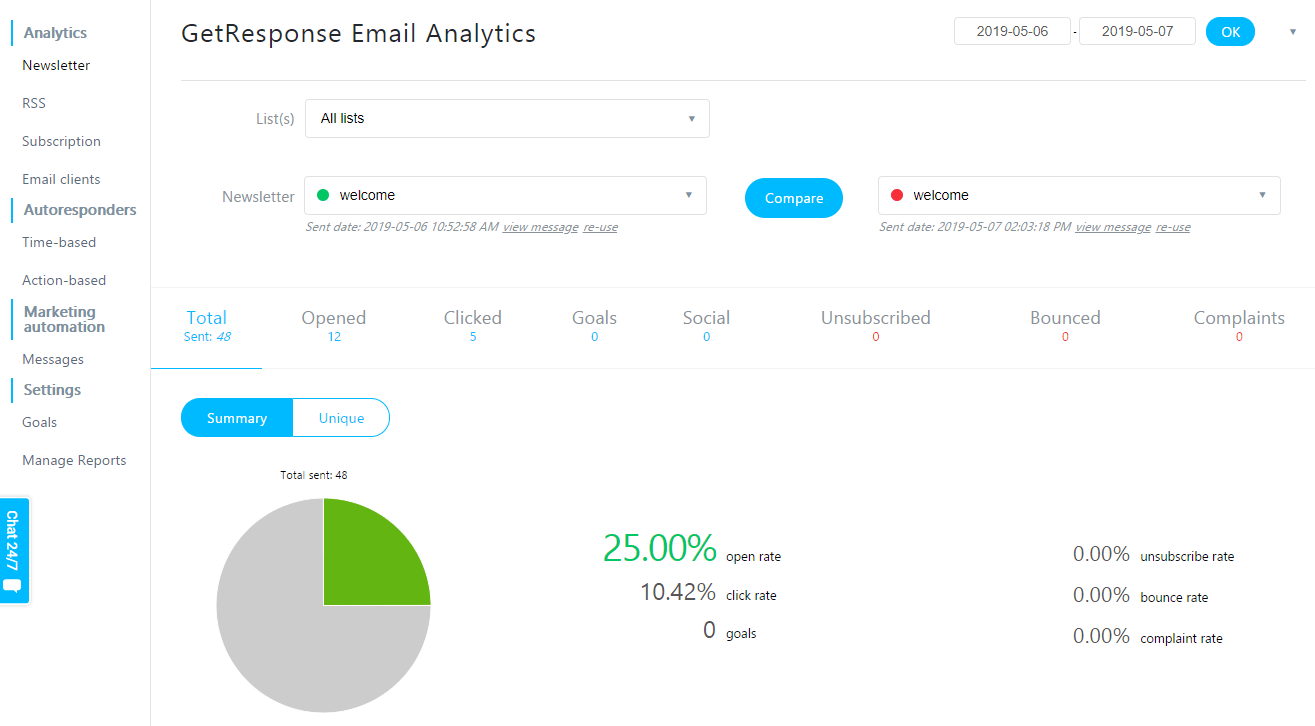
Key Features
- Autofunnel builder. Create full sales journeys from opt-in to conversion in one tool. Ideal for building revenue funnels without coding;
- Webinar integration. Run live sessions directly from your email platform. Educate and convert your audience in real time;
- AI email generator. Quickly produce optimized emails with smart copy suggestions. Save time and boost performance with AI-powered content;
- Conversion-focused tools. Includes landing pages, sales funnels, and automation in every plan. Built to drive leads and maximize ROI from day one.
Pros and Cons
| Feature | GetResponse | Mailjet |
| Free trial | No (Only 30-day trial) | Yes (Free tier with 6,000 emails per month) |
| Pricing | Starts at $15/month for 1,000 contacts & unlimited emails | Starts at $17/month for unlimited contacts & 15,000 emails/month |
| Email editor | Drag-and-drop editor + AI email generator | Drag-and-drop editor only |
| Templates & landing pages | Pre-designed templates + full landing page builder | Pre-designed templates + landing page builder |
| Funnels | Autofunnel builder for complete sales journeys | No funnel builder |
| Webinars | Built-in live webinar platform | Not available |
| CRM | Simple CRM for contact management & segmentation | No native CRM |
| Automation | Advanced automation with conversion-focused workflows | Basic automation |
| Analytics | In-depth campaign reporting & conversion tracking | Standard analytics & reporting |
| Multichannel | Email + landing pages + funnels + webinars + automation | Primarily email & SMS |
| Support | Email & live chat support, resources for beginners | Email support; live chat for premium tiers |
Mailjet vs. GetResponse
Mailjet shines for teams that need straightforward email marketing with collaboration at the core—its real-time editing and transactional email support make it especially useful for businesses that want campaigns and operational messages in one place.
GetResponse, on the other hand, positions itself as an all-in-one platform. Beyond email and landing pages, it includes sales funnels, advanced automation, webinars, and even a built-in CRM. That broader toolkit makes it a better fit for businesses aiming to centralize their marketing rather than piecing together separate tools.
It has an accessible interface that makes it easy for a single person to set up and monitor multiple campaigns at once. The analytics dashboard gives immediate feedback on campaign performance with ease.
— Sasha from Capterra
Moosend — Affordable Marketing with Automation Capabilities
Moosend is an affordable email service provider that doesn’t skimp on features, offering advanced marketing automation capabilities at a competitive price. It’s proof that you don’t need a massive budget to access powerful marketing tools.
Moosend pricing: Starts at $7/month for up to 1,000 contacts | 30-day free trial available.
Moosend’s visual automation editor makes it simple to build advanced email sequences driven by user behavior, demographics, and engagement. Compared to Mailjet, which keeps automation more basic, Moosend gives you greater flexibility to target audience segments with personalized content while also handling tasks like managing inactive subscribers automatically.
It also goes further with advanced tools such as dynamic content and A/B testing to refine campaigns for better performance. Mailjet supports split testing as well, but I found Moosend’s combination of personalization and automation makes it easier to optimize at scale.
What really sets this Mailjet alternative apart is its balance of features and affordability. While Mailjet emphasizes collaboration and transactional sending, Moosend provides a broader set of automation and personalization options at a very competitive price point. What’s not to like?
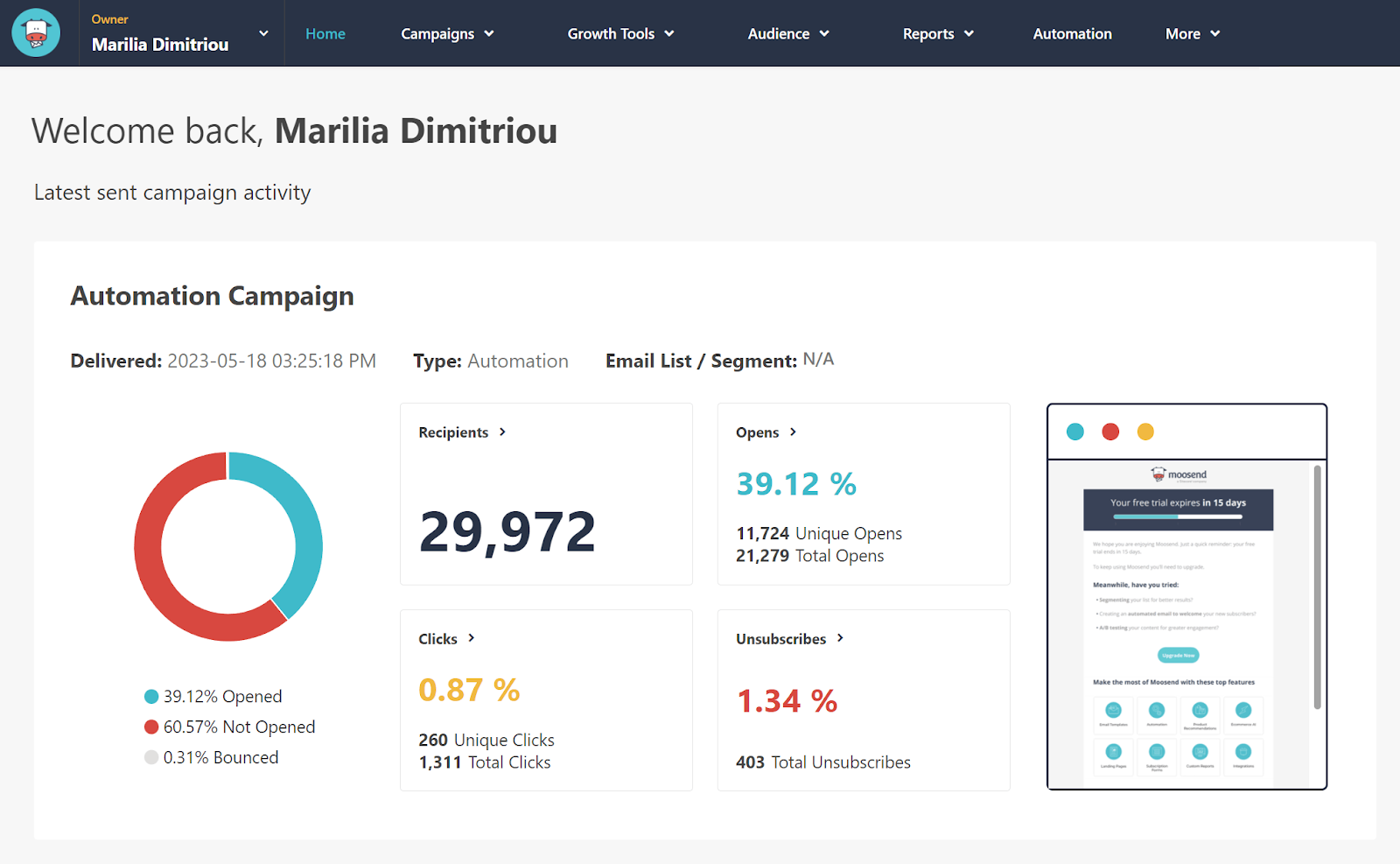
Key Features
- Competitive pricing plans. Whether you’re just starting or have a growing list of subscribers, you’ll find a Moosend plan that fits your budget and provides excellent value;
- Advanced segmentation options. Moosend’s powerful segmentation tools allow you to divide your audience based on demographics, behavior, purchase history, and more, ensuring your emails resonate and drive conversions;
- Landing page builder. Create high-converting landing pages to capture leads and promote your offers without needing a separate landing page platform.
Pros and Cons
| Feature | Moosend | Mailjet |
| Free trial | No (30-day trial) | Yes (Free tier with 6,000 emails per month) |
| Pricing | Paid plans start at $7/month for 1,000 contacts | Paid plans start at $17/month for unlimited contacts & 15,000 emails/month |
| Automation | Visual automation editor with advanced workflows | Basic automation workflows |
| Personalization | Dynamic content, behavioral targeting, auto list cleaning | Standard personalization options |
| A/B testing | Yes (subject lines, content, send times) | Yes (more limited testing) |
| Segmentation | Granular audience segmentation by behavior, demographics, engagement | Basic list-based segmentation |
| Templates & editor | Drag-and-drop editor with modern templates | Drag-and-drop editor with fewer templates |
| Analytics | Detailed campaign performance and optimization tools | Standard analytics & reporting |
| Transactional email | Limited transactional features | Built-in transactional email support |
| Support | Email support + resources for users | Email support; live chat for premium tiers |
Mailjet vs. Moosend
Mailjet is a good fit for teams that value collaboration and straightforward email marketing. Its real-time editing and transactional email support make it especially practical for businesses that need multiple people working on campaigns, or those who want to handle both marketing and operational emails from one platform.
Moosend, by contrast, leans heavily into automation and personalization. Its visual automation builder, dynamic content options, and built-in A/B testing provide more advanced tools for tailoring messages and optimizing performance.
Despite that sophistication, Moosend remains highly affordable, making it appealing for businesses focused on marketing automation without stretching their budget.
We have tried a lot of different autoresponders and this has been the best of the lot. You’ve got high-end functions but without the cost of some of the bigger companies. We have been incredibly pleased with the deliverability we have received from Moosend.
— Stephan from Capterra
Constant Contact — Great for Small Business Owners
Constant Contact is a user-friendly email marketing platform designed for small businesses. It offers a simple and intuitive interface and single sign-on options, making it easy for even those new to email marketing to get started.
Constant Contact pricing: Starts at $12/month up to 500 contacts | Free 30-day trial available.
Constant Contact comes with a drag-and-drop editor, a library of ready-made templates, and flexible customization tools for building polished campaigns. Mailjet offers similar editing features, but Constant Contact adds an extra edge with its wide range of integrations, making it easier to connect with other business tools and fit into existing workflows.
The platform is also user-friendly and backed by plenty of resources and support, which can be helpful for smaller teams. Like Mailjet, you can import contacts, grow your lists through automation, and track campaign results—but Constant Contact makes it simple to view these efforts alongside your broader marketing activities.
It also provides a 30-day free trial, much like Mailjet’s free plan, giving businesses the chance to try out the platform and its features before deciding on a paid subscription.
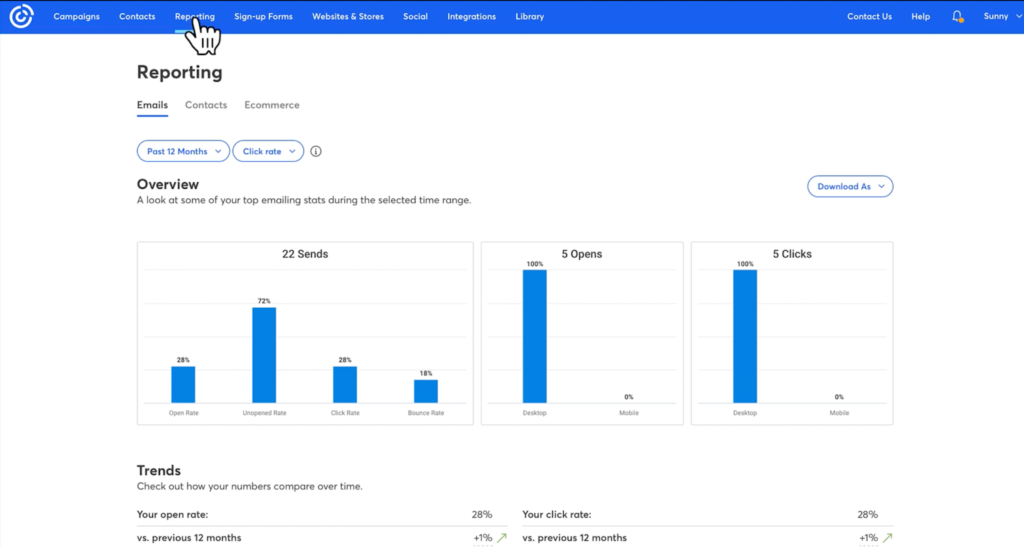
Key Features
- Landing page + email builder. Run end-to-end campaigns with list-building tools included. Perfect for promotions, events, and lead capture;
- Event management tools. Organize and promote webinars, workshops, and fundraisers easily. Everything you need to manage event marketing in one place;
- Phone and chat support. Hands-on help makes it appealing to users needing guidance. Get real-time assistance whenever you’re stuck;
- Email + event marketing combo. Combine email templates with RSVP tools and reminders. Ideal for promoting and managing in-person or virtual events.
Pros and Cons
| Feature | Constant Contact | Mailjet |
| Free trial | No (30-day trial only) | Yes (Free tier with 6,000 emails per month) |
| Pricing | Starts at $12/month up to 500 contacts & unlimited emails | Starts at $17/month for unlimited contacts & 15,000 emails/month |
| Email & landing page builder | Drag-and-drop builder + landing pages | Drag-and-drop email & landing page builder |
| Templates | Large library of customizable templates | Smaller template selection |
| Event marketing | Built-in event management & RSVP tools | Not available |
| Integrations | Wide range of integrations with business tools | More limited integration ecosystem |
| Automation | Basic workflows & list growth tools | Basic workflows with transactional email support |
| Analytics | Campaign tracking integrated with events & activities | Standard email performance metrics |
| Support | Phone and chat support included | Email support; chat only on higher plans |
| Transactional email | Not a core focus | Strong transactional email support via API/SMTP |
Mailjet vs. Constant Contact
Mailjet is a strong choice for teams that need streamlined collaboration and transactional email support. Its real-time editing and developer-friendly API make it especially appealing for groups working together on campaigns or businesses that want to combine marketing and operational emails in one platform.
Constant Contact, meanwhile, puts more emphasis on ease of use and integrations. Its drag-and-drop editor, large template library, and wide range of third-party connections make it simple for non-technical users to design campaigns and tie them into existing business workflows.
It also provides extensive resources and customer support, which can be a big plus for smaller teams getting started with email marketing.
Constant Contact has been very useful for e-news, event, and fundraising communication. For the most part the platform is user friendly and intuitive to use. It’s important to keep an eye on the number of contacts in your system and remove any outdated ones because Constant Contact bills by the number of contacts in your account.
— Allyson from Capterra
4 Mailjet Alternatives to Send Transactional Emails
Looking for a Mailjet alternative for transactional emails? Here are the top substitutes I recommend:
Brevo — Strong CRM Tools and Transactional Emails
Brevo combines email marketing with robust CRM capabilities and a reliable transactional email service.
Brevo pricing: Starts at $8/month for up to 500 contacts + 5,000 monthly emails| Brevo Free plan available.
In my experience, Brevo makes campaign design really straightforward with its drag-and-drop builder and ready-to-use templates. Mailjet has a similar editor, but I find Brevo’s interface a bit smoother when it comes to creating polished emails quickly.
Where Brevo really stands out for me is automation. I can set up workflows triggered by customer actions or specific events, whereas Mailjet’s automation feels more limited. The built-in CRM is another plus—I can manage contacts, segment lists, and send highly personalized campaigns without needing an extra tool.
Both platforms handle transactional email well, but Brevo gives me more flexibility by tying it directly into the CRM and automation flows. On top of that, I like having extras like SMS marketing and landing page creation tool bundled in.
So while Mailjet is strong for team collaboration and transactional basics, Brevo gives me a more complete marketing setup in one place.

Key Features
- Transactional email capabilities. Automate purchase confirmations and shipping updates without external tools. Ensure reliable delivery of essential order-related emails;
- Flexible contact pricing. Pay based on email volume, not contacts—ideal for growing lists on a budget. Control costs as your list expands;
- Drag-and-drop editor. Easily design emails using intuitive tools and reusable email templates. No coding skills needed to create professional campaigns;
- Centralized platform. Offers CRM, SMS, and automation in one platform. Ideal for teams wanting centralized control without third-party tools.
Pros and Cons
| Feature | Brevo | Mailjet |
| Free plan | Yes (300 emails/day with unlimited contacts) | Yes (6,000 emails/month, contact limits apply) |
| Pricing | Starts at $8/month for up to 500 contacts + 5,000 emails/month | Starts at $17/month for unlimited contacts & 15,000 emails/month |
| Email builder | User-friendly drag-and-drop editor with templates | Drag-and-drop editor with fewer templates |
| Automation | Advanced workflows with multichannel triggers | Basic automation workflows |
| CRM | Built-in CRM with contact management & segmentation | No native CRM |
| Multichannel | Email, SMS, live chat, WhatsApp, and marketing automation | Primarily email + transactional SMS |
| Landing pages | Built-in landing page creator | Built-in landing page builder |
| Transactional email | Reliable SMTP relay and API for transactional sends | Strong transactional email support |
| Analytics | Real-time campaign reporting & deliverability monitoring | Standard campaign analytics |
| Support | Email & chat support, phone for premium plans | Email support; live chat for higher tiers |
Mailjet vs. Brevo
When weighing Mailjet against Brevo, the strengths become clear in different areas. Mailjet focuses on efficient email delivery with solid collaboration features. Its real-time editing and straightforward interface make it easy for teams to work together on campaigns, while the API support gives developers the tools to handle transactional email alongside marketing.
Brevo, by contrast, positions itself as more than just an email tool. In addition to newsletters, it offers SMS campaigns, live chat, push notifications, and a built-in CRM, giving businesses the ability to manage multi-channel communication from one place. Its automation system is also more advanced, letting you create personalized workflows that adapt to subscriber behavior across channels.
I’ve been using Brevo for a while now, and honestly, there’s a lot to like about it. First off, it’s incredibly convenient—it’s like having all my marketing tools in one place. It’s all right there, saving me the hassle of juggling multiple platforms.
— Yuri from G2
Also read: 11 Best Brevo Alternatives for Email Marketing (July 2025)
SendGrid — Scalable and Built for Developers via API
SendGrid, an email API provider, is popular for developers seeking a scalable and reliable email delivery service. Its robust API allows for seamless integration with applications and websites.
Sendgrid pricing: Starts at $20/month for sending up to 100,000 emails/month | 60-day free trial available.
SendGrid is heavily focused on transactional email and reliable delivery, making it a strong alternative to Mailjet, particularly for developer-driven teams. While Mailjet balances marketing and transactional use cases, SendGrid is built first and foremost as a dependable SMTP email service.
Its API-first approach gives developers more customization options than Mailjet, with broad language support and extensive documentation to simplify integration. SendGrid also goes deeper on infrastructure features, offering dedicated IPs, deliverability alerts, and detailed logs, which is another reason to switch from Mailjet
Both platforms can handle transactional and marketing emails, but SendGrid’s SMTP relay is optimized for sending at scale directly through applications. Mailjet is more approachable for marketers, while SendGrid is better suited to businesses that prioritize developer control and infrastructure-level email delivery.
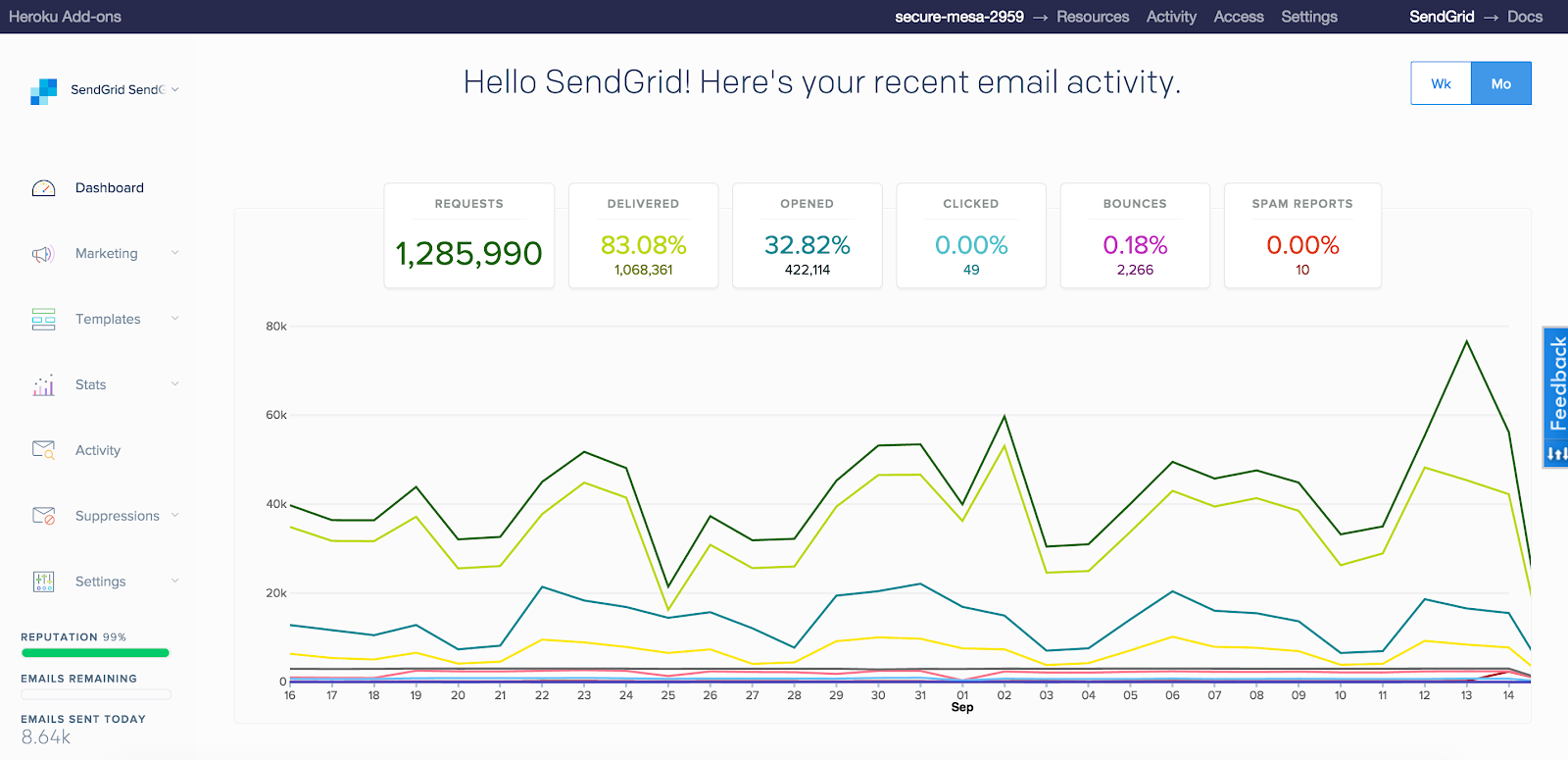
Key Features:
- Robust API. SendGrid’s well-documented and feature-rich API eliminates the need for complex workarounds and allows for seamless automation of email workflows, from transactional emails to marketing campaigns;
- Flexible webhooks. Beyond the API, SendGrid offers powerful webhooks that provide real-time notifications and data about your email events;
- Built for high-volume sending. Whether you’re sending thousands or millions of emails, SendGrid’s robust infrastructure is designed to handle massive email volumes;
- Expert support. SendGrid’s dedicated support team is available to provide technical expertise and guidance.
Pros and Cons
| Feature | SendGrid | Mailjet |
| Free plan | No (60-day free trial) | Yes (6,000 emails/month, contact limits apply) |
| Pricing | Starts at $15/month for up to 300,000 emails/month | Starts at $17/month for unlimited contacts & 15,000 emails/month |
| API & developer tools | Robust, well-documented API with flexible integrations | Developer-friendly API, simpler for basic use cases |
| Webhooks | Advanced, real-time event notifications | Standard webhook support |
| High-volume sending | Optimized for massive transactional & marketing email delivery | Supports large volumes but less infrastructure-focused |
| Deliverability tools | Dedicated IPs, deliverability alerts, reputation monitoring | Standard deliverability features |
| Marketing features | Basic campaign builder, fewer design tools | User-friendly editor with team collaboration features |
| Transactional email | SMTP relay + API built for reliability & scale | Built-in transactional email support |
| Analytics | Detailed logs & performance monitoring | Standard campaign analytics |
| Support | Dedicated technical support for developers | Email support; live chat for premium tiers |
Mailjet vs. SendGrid
SendGrid is geared toward developers who need to manage transactional email at scale, whereas Mailjet takes a more balanced approach by combining transactional and marketing features with ease of use.
With Mailjet, however, you get a more intuitive campaign builder, collaborative editing, and content tools designed for marketing teams. It doesn’t offer the same level of customization as SendGrid, but it’s far more approachable for marketers creating newsletters, promotions, or simple automation workflows. The winner of the Mailjet vs. SendGrid debate is only decided with your marketing needs.
Really easy to set up and integrate into our existing application and user flow. We’ve never had an issue with our SendGrid email service, and have been incredibly reliable. Easy to track on the dashboard and analyse open rate.
— Charlie from Capterra
Mailgun — Customizable Email API for Developers
Mailgun is a powerful transactional email service designed specifically for developers who need to build custom email infrastructure.
It provides a robust API that allows you to integrate email functionality directly into your applications and websites, giving you complete control over your email sending process.
Mailgun pricing: Starts at $15/month for unlimited contacts and up to 10,000 emails/month | Mailgun Free plan available.
Mailgun and Mailjet serve very different purposes. Mailgun gives me a robust API that integrates directly into applications and websites, so I have complete control over every part of the sending process. Mailjet also has an API, but Mailgun’s is far more flexible for developers who need to customize email infrastructure.
Deliverability is another area where Mailgun shines. It prioritizes inbox placement with advanced optimization features and provides detailed tracking and analytics to monitor performance.
With Mailgun, I can send transactional or marketing emails and even build custom solutions around my workflows. The webhooks and event tracking make it easy to automate processes and get real-time notifications—something Mailjet doesn’t emphasize as strongly.

Key Features:
- Powerful API. Mailgun’s robust API empowers developers to integrate email sending capabilities directly into their applications effortlessly;
- Customizable templates. Mailgun allows you to craft dynamic templates that personalize content programmatically, creating truly engaging email experiences that resonate with your audience;
- Dedicated IPs. This is crucial for businesses that send high volumes of email and want to avoid the pitfalls of shared IP pools, safeguarding your sender reputation;
- Advanced email validation. Minimize bounces and protect your sender reputation with Mailgun’s sophisticated email validation system.
Pros and Cons
| Feature | Mailgun | Mailjet |
| Free plan | Yes (3,000 emails/month) | Yes (6,000 emails/month, contact limits apply) |
| Pricing | Starts at $15/month for 10,000 emails & unlimited contacts | Starts at $17/month for unlimited contacts & 15,000 emails/month |
| API & developer tools | Highly flexible, developer-first API for full control | Developer-friendly API, but less customizable |
| Templates | Dynamic, programmable templates for personalization | Drag-and-drop editor with pre-designed templates |
| Deliverability | Advanced optimization, reputation monitoring, and validation tools | Standard deliverability features |
| Dedicated IPs | Available for high-volume senders | Available on higher-tier plans |
| Email validation | Built-in validation system to reduce bounces | No native validation system |
| Webhooks & events | Real-time tracking, automation, and event notifications | Basic webhook and tracking support |
| Transactional email | Core focus with SMTP & API at scale | Strong transactional support, easier to use for non-devs |
| Analytics | Detailed logs and performance metrics | Standard reporting & campaign analytics |
Mailjet vs. Mailgun
Different platforms excel at different things, which is why this Mailjet vs. Mailgun showdown is so tough. I turn to Mailjet when I need to run marketing campaigns alongside some transactional sending.
Mailgun, on the other hand, is built for developers—it’s ideal for applications that need to send email programmatically. Its logging and debugging tools are far more detailed than Mailjet’s, making troubleshooting much easier.
That said, Mailgun doesn’t include a campaign builder. So if you want marketing features, Mailjet is the better fit. If you only need transactional email with full control, Mailgun is the way to go.
We use Mailgun for a while now and we really like it. Currently we’re using it as a standard for all our transactional mailings on new projects. Also, when we experienced difficulties and reached out to the support, we’ve been amazed about their qualified response.
— Andreas from Capterra
Also read: 7 Best Mailgun Alternatives for Email Delivery in 2025
Postmark — Speedy & Secure Transactional Emails
Postmark specializes in transactional email delivery, ensuring your important emails, such as order confirmations, password resets, and shipping notifications, reach their recipients quickly and reliably. It’s like having a dedicated postal service for your most critical communications.
Postmark pricing: Starts at $15/month for unlimited contacts and up to 10,000 emails/month | Postmark Free plan available.
With Postmark’s straightforward API and clear documentation, I’ve found it easier to get started compared to Mailjet—especially for developers who are new to transactional emails.
Postmark also places a strong emphasis on security and compliance, which makes it a solid option for businesses that need to handle sensitive customer data. While Mailjet can manage large-scale sends, Postmark is purpose-built for high volumes of transactional messages, ensuring important emails are delivered quickly and consistently.
The biggest difference is in focus. Mailjet supports both marketing campaigns and transactional email, but Postmark specializes solely in transactional communication. That specialization means individual, personalized messages—like password resets and order confirmations—are optimized for deliverability and less likely to get caught in spam filters.
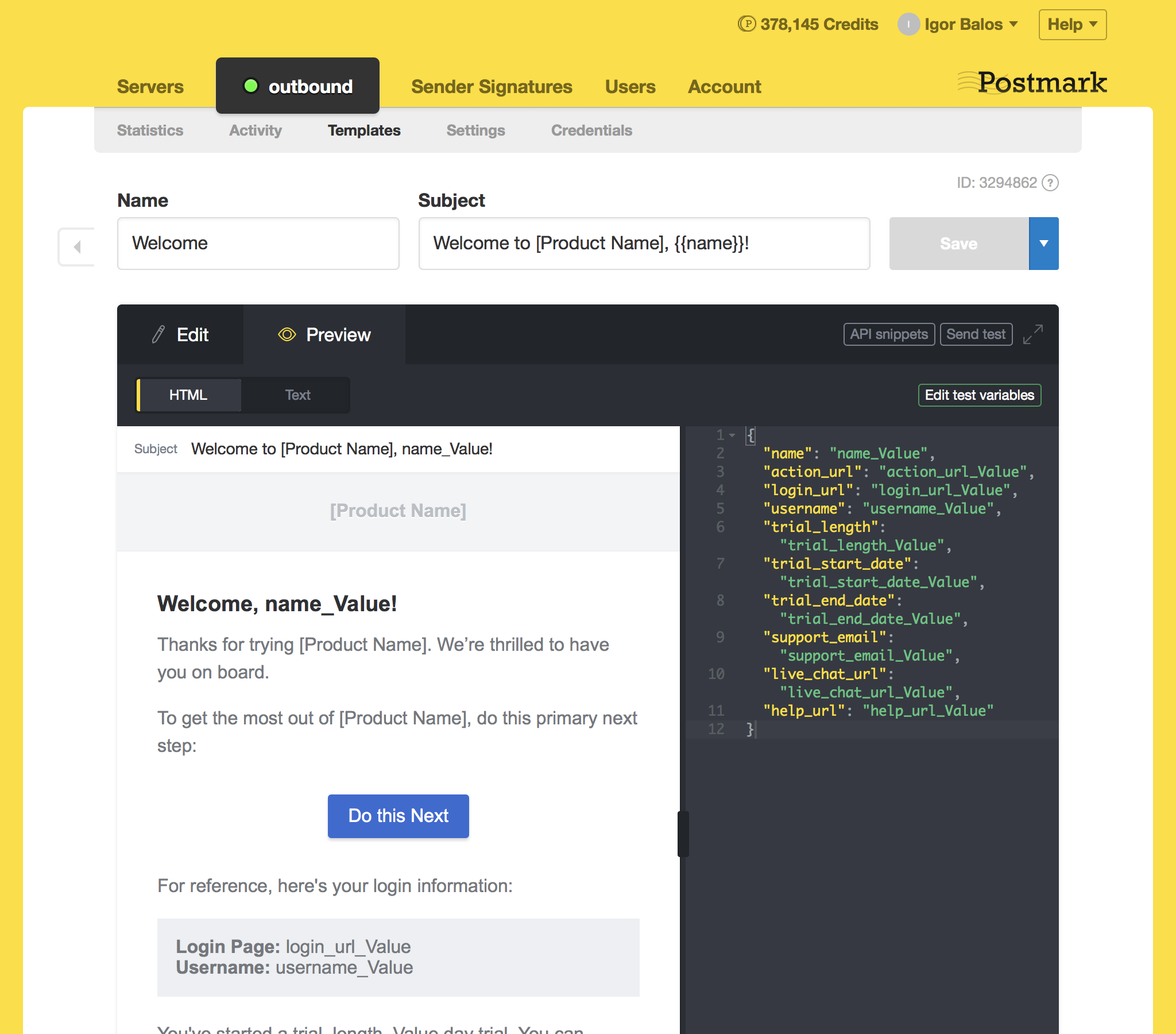
Key Features:
- Optimized for speed. Postmark’s streamlined systems and direct routes to mailbox providers ensure that your transactional emails reach their destination in seconds;
- Exceptional deliverability. Their dedicated IP addresses, rigorous authentication protocols, and proactive reputation monitoring work in unison to keep your emails out of spam folders and ensure they land in the inbox;
- Compliance-forward approach. Postmark simplifies compliance by offering built-in features like unsubscribe management, data processing agreements, and clear documentation;
- Dedicated support. Their responsive and knowledgeable support team can answer your questions, troubleshoot issues, and provide guidance.
Pros and Cons
| Feature | Postmark | Mailjet |
| Free trial | Yes (trial available) | Yes (6,000 emails/month, contact limits apply) |
| Pricing | Starts at $15/month for 10,000 emails & unlimited contacts | Starts at $17/month for 15,000 emails |
| Focus | Purpose-built for transactional emails only | Supports both marketing campaigns & transactional email |
| Deliverability | Exceptional (optimized for transactional emails, less likely to hit spam) | Solid, but weaker than transactional specialists |
| Speed | Direct routing for near-instant delivery | Reliable but not optimized for speed |
| API & developer experience | Simple, well-documented API for fast setup | Developer-friendly API, more general-purpose |
| Security & compliance | Strong compliance features (unsubscribe management, DPAs, monitoring) | Standard compliance and security |
| Templates & campaigns | No campaign builder (transactional only) | Drag-and-drop editor + campaign builder |
| Dedicated IPs | Available, optimized for transactional sending | Available, but no dedicated IP pools |
| Support | Dedicated, highly responsive developer-focused support | Email support, live chat for higher tiers |
Mailjet vs. Postmark
Both Postmark and Mailjet are reputable email service providers, but they cater to different needs. Postmark excels in transactional emails, prioritizing speed, reliability, and deliverability for mission-critical communications.
Mailjet, on the other hand, offers a more versatile platform encompassing both marketing and transactional emails, with a focus on user-friendliness and design flexibility (though advanced capabilities may require subscribing to a separate plan).
It’s a great SMTP provider that is easy to set up as well as great delivery and clean IPs. On top of that, it also has a DMARC reporting tool which I like and recommend to any beginner or non-techy person out there. Support is great and quick to reply to any issues you might have.
— Dame from G2
Email Marketing Platforms Cost Calculator
Choosing the right email marketing platform—one that aligns with your audience size, essential features, and budget—can feel overwhelming.
That’s why we created Sender’s price calculator: a quick, simple tool to help you compare options and discover the cheapest plan for your business.







